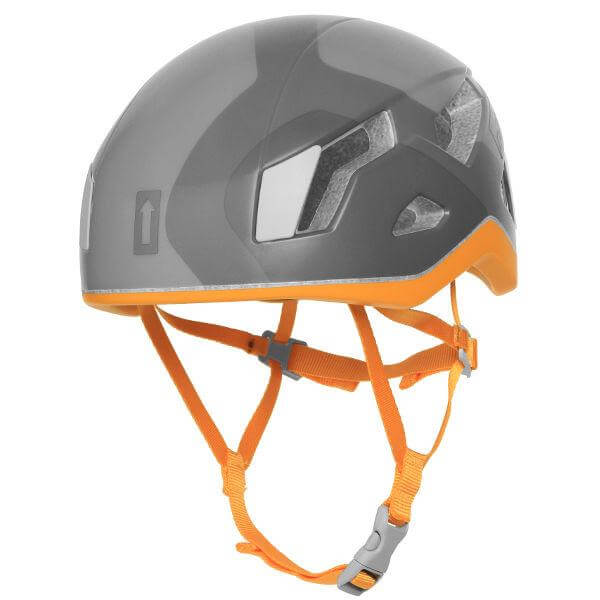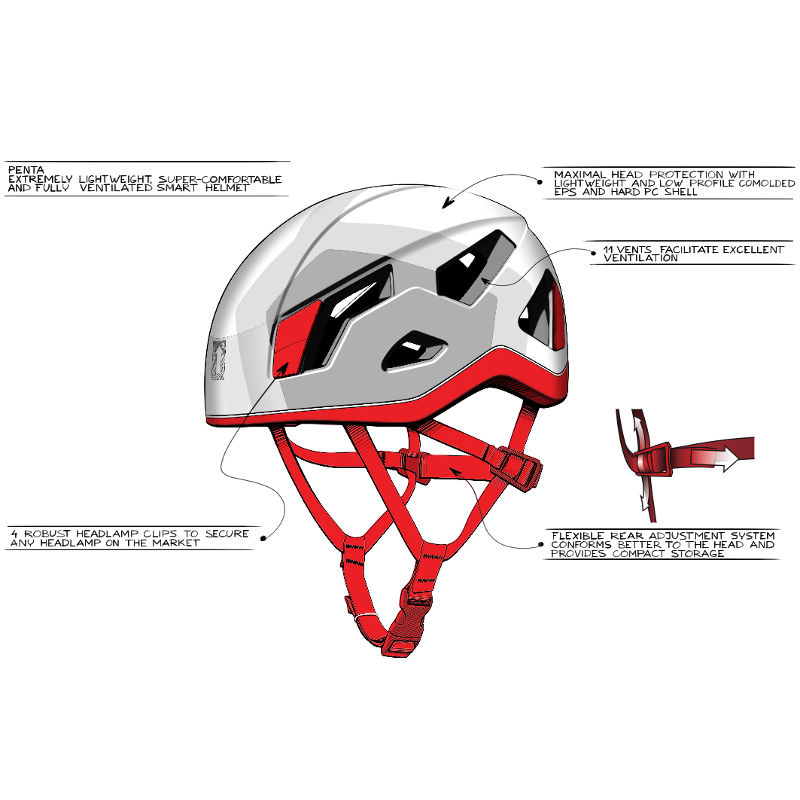Penta
Description
Penta is extremely lightweight, super-comfortable and fully ventilated climbing helmet. All this combined with a maximum head protection. For its comfort and lightweight design is ideal for use in sport climbing, mountaineering traditional climbing or via ferrata.
compact upper part protects the user from falling objects and stil keeps low profile
hard PC shell avoids sharp objects penetration while PS foam absorbs the impact energy
hard PC shell also protects the bottom edge from mechanical damage
inside padding is fully removable and washable
eleven large vents with more than 56 cm² allow excellent ventilation
robust headlamp clips secure any headlamp on the market
comfortable and flexible rear retention system conforms better to any head and provides space saving storage (can be easily folded into the helmet)
narrow straps of the retention system are very soft and light and do not press so as standard hard-plastic headbands
soft and wide chin strap with an extended length provides maximum comfort and allows to wear a hat under the helmet
ultra light helmet for all climbing activities
Retail price
This Product is Hard to Find.
We don’t know where you can buy this item online in the US. We’ll continue to check all the major retailers and will update this page as soon as we find one.
If you know where to find this online in the US, let us know, and we’ll add the link.

Weight (g)  Weight (g)In grams, the weight, as stated by the manufacturer/brand. If there are differences in weight (due to multiple size or optional accessories) we note those here. | 205 g One Size: 205 g / 7.23 oz |
Gender  GenderThis is the gender as stated by the manufacturer/brand. We use the term "Men" and "Unisex" interchangeably, as there is no difference between these types of helmets. |
Unisex |
Size Range  Size RangeThe sizing options of the helmet according to the manufacturer. | 20.00 in - 24.00 in One Size: 51-60 cm / 20-24 in |
Features  FeaturesBike Cert (EN 1078)The EN certification for helmets used for bicycling and skating. The major difference in testing 1078 involves needs for more head coverage and for the helmet to pass a deflection or 'roll-off' test of the impact force. BrimHaving a brim on a helmet may be inconsequential to some climbers but they make a great additional bit of protection against sun, rain and falling debris like small rocks or verglass. Multiple SizesThis is helpful for those with particularly small or large heads because helmets that come in 2 or 3 sizes cover a broader range of head size. Usually these are denoted as size 1 or 2, though some brands have S/M and M/L. Face Shield CompatibleFace shields are a part of PPE that could be handy when drilling, developing and cleaning particularly dirty remote routes. Usually only used by work at height professionals. MIPS technologyMIPS or Multidirectional Impact Protection System is a technology designed to reduce the amount of impact force that makes it to the brain. This is accomplished by adding a low friction cap between the liner and the helmet, allowing the shell to deflect around the head rather than transfer the forces from impact directly to the wearer. Many bicycle helmets include this feature and it is starting to be applied to sports like skiing, motorcycling and climbing. Many MIPS helmets are also EN1078 compliant. Ponytail CutoutSo far these are only found in "women's" helmets. It's a cutout / notch area that accommodates a low hanging ponytail hairstyle. RECCO® reflectorThese are used in locating someone missing or buried in an avalanche and are becoming more common in climbing gear due to the increased popularity of ski mountaineering. Though they are more often sold as something to add onto the helmet than being built into one, some manufacturers have begun to build them in. Ski Cert (EN 1077)The EN certification for helmets used for climbing and skiing. This test is simpler than the EN/UIAA one performed for helmets in general, but increases the amount of force that a helmet must endure. Likely this to simulate the faster speeds involved with downhill skiing impacts versus rockfall or climber accidents. This cert becoming more common in helmets as SkiMo popularity increases and more climbers are adding backcountry skiing to their mountaineering repertoire. |
|
Quick Adjust  Quick AdjustQuick Adjust refers to the straps of the helmet. Do you want the ability to ability to "quickly" adjust the fit. This could be a dial, or other plastic pieces. Really, most climbers don't need to change the fit of the helmet often, unless you're climbing with and without hats, or you have big hair that flattens and then requires tightening after climbing for awhile. |
No |
Vents  VentsRefers to openings in the helmet body to allow air flow. Commonly found in most helmets these days, but often more so in foam and hybrid foam helmets than traditional hardshell polycarbonate shells. Learn More
Click here to read more on helmet construction |
Yes |
Headlamp Compatable  Headlamp CompatibleMany helmets include hooks or clips for holding a standard headlamp in place, which is quite useful for the caver or alpinist. Ask any climber who has been benighted and they’ll tell you just how useful this feature can be. |
Yes |
Face Shield Compatable  Face Shield CompatibleFace shields are a part of PPE that could be handy when drilling, developing and cleaning particularly dirty remote routes. This feature isn't very common in climbing helmets and usually only used by work at height professionals. |
No |
| Certification | CE, EN, UIAA |
The Singing Rock Penta is a comfortable, lightweight molded foam helmet with good ventilation, making it a well-rounded and versatile helmet for rock and ice climbers. The soft, nylon chinstrap and suspension system makes this unisex helmet attractive for both male and female climbers as it allows long hair to fit comfortably in the rear. Low profile headlamp attachment clips are effective and stay out of the way of slings and clothing while keeping your light in place.
The Singing Rock Penta is a very affordable helmet made with lightweight foam. It only comes in one size, and is not very adjustable, so one must be sure that it fits comfortably before committing to a purchase. If you are lucky, then the Penta can be a fantastic value purchase, while the majority are likely to find that the fit is too small, eliminating it as a choice for consideration.
One of the reasons that I switched to a lightweight helmet is I realize that heavier helmets are simply not as comfortable and I'm more likely to wear a helmet if it's comfortable. After I tried on a friend's, I realized that I didn't even notice that I was wearing it, so I started wearing one all the time. The Penta comes in blue, gray, red, and white.
Campers’ Corner called me this week and told me the Penta arrived at their store and I was really excited to wear it and feel how the helmet stands up. When you first picked up the helmet, you can feel the lightweight foam without excessive plastic parts on it and it has a great CG with weight evenly distributed around the helmet. The adjustable straps at the back of the helmet eliminated the traditional plastic dials which I thought was a great idea. The plastic dials either breaks or it becomes sticky rubber/plastic mix after being in our tropical climate for sometime. These adjustable straps on the Penta, feels soft and skinny almost ‘g string’ kinda feel. It is also not hard to adjust the straps when you have your helmet on.
The Penta is CE and UIAA certified, and has a plastic veneer that protects it from being dinged by jiggling cams or ice screws when it’s in your pack, and from the everyday sort of damage that it might otherwise get from being dropped or tossed in the back of your car. Four plastic-lift tabs accept a headlamp strap quickly and easily. The helmet is foam and rides directly on your head without a suspension. Generous cutouts on the sides and back let air in, but sweat still builds up since foam helmets are basically insulated koozies for your head, a point you’ll appreciate on cold days, but not so much on hot ones.
The Singing Rock Penta is not only of the lightest, but also one of the most comfortable, helmets I’ve used. At just 208 grams (one size), it is slightly heavier than the lightweight champ Petzl Sirocco (170 grams, size 2) but a touch lighter than Petzl’s Meteor III+ (218 grams, size 2). This firmly puts it in competition with other lightweight helmets out there — but it’s significantly cheaper at just $70 USD msrp (vs. the others at approx. $120 USD). But regardless of the weight and cost, what really sets it apart from the others is how low-profile it is. It’s hard to see, and even harder to demonstrate, but the small size of the Penta is immediately obvious when you pull a hood over it. It sits low and the straps hug it close, so even with a tight hood you maintain good head mobility. This one thing alone has made it the one helmet I now wear everywhere, all the time.
No voice but the video shows all the features of Penta Helmet.
A pictoral representation of the UIAA-106 and EN-12492 standards for helmets.
The UIAA equipment standard provides a baseline for equipment performance in a test lab under controlled conditions on new equipment. Although these test conditions are relevant to the conditions encountered climbing, conditions encountered at the crags and the condition of the equipment are equally important. This recommendation from the UIAA member federation The British Mountaineering Council (BMC) provides vital equipment information that is NOT explicitly addressed in the standard, particularly failure modes of the equipment and recommendations for the use, inspection, maintenance, and retirement of equipment.






























